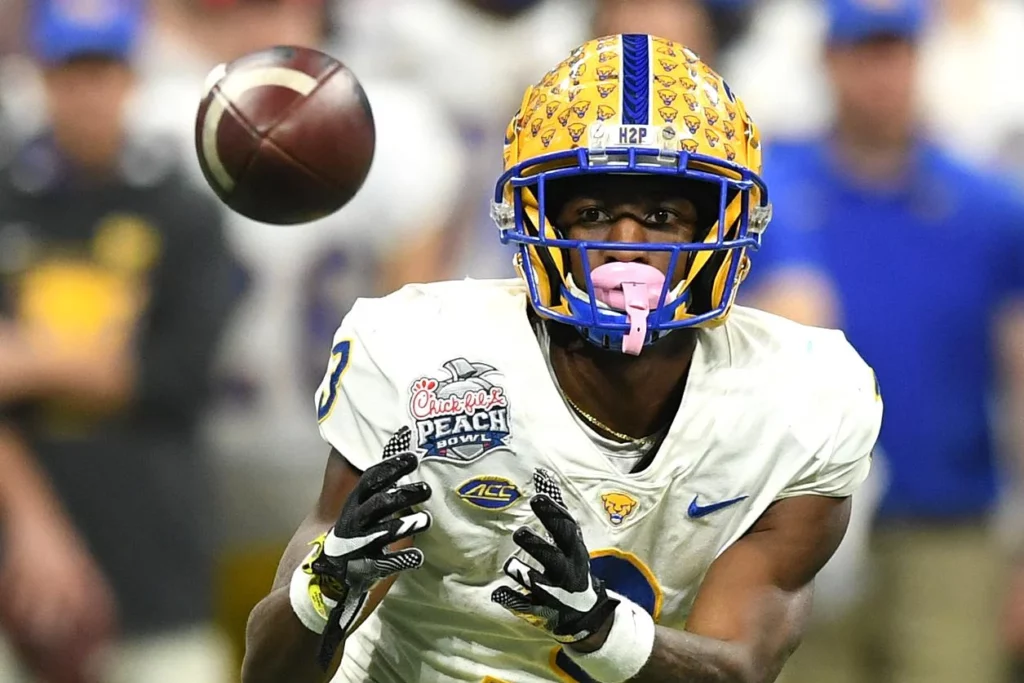The Star Wide Receiver Who Has All of College Football Panicking
This controversy is being treated as a crisis, but it’s more a sign of what’s to come…
Alex Kirschner (Slate.com) — No sport loves an existential crisis like college football. The most durable theme over the sport’s history—more than crunching hits, good tailgating, and marching bands—is that any big, structural change is met with predictions that it will be the thing that brings about the ruination of the sport or at least relegates it to the margins of American society.
In 1902, a former state senator in Utah predicted that “the taint of professionalism will kill college football,” according to the Deseret News. That was the first newspaper clipping I could find of someone warning that something would “kill college football.” There were dozens more over the coming decades, often with that exact verbiage and sometimes with different variations of an idea that a new thing would harm or murder the sport. Other predicted assassins of college football over the years included gambling, creating a professional league, ticket scalping, too much nonconference play, “overemphasis” on athletics, extended training camps, neutral-site games, “secret deals” to pay for players, the draft (into the military, not the NFL), introducing the two-platoon system that allowed substitutions for offense and defense, televising games (in the 1950s), overly expensive helmets, Title IX, and, at many different moments, integration.
The sport must be resilient to still be around, and for one of its conferences to be closing in on a TV deal worth more than a billion dollars a year. But the past week has seen renewed hand-wringing around the country over the intersection of two recently passed reforms: one to allow players to transfer schools one time without having to sit out a season, as used to be custom, and another to let athletes make money from third parties for appearances and sponsorships. The latter has created a de-facto pay-for-play setup at many schools, where boosters organized in “collectives” are dangling money as a recruiting inducement. The latest and brightest flashpoint is the ongoing transfer process of Jordan Addison, a rising junior wideout at the University of Pittsburgh who just won the Biletnikoff Award as the nation’s top pass-catcher.
Addison entered his name into the NCAA’s transfer portal just before a May 1 deadline, and a swirl of reporting—days before that—indicated that USC was a likely landing spot. Addison’s camp insists that he has not made up his mind on where he will play in 2022.
Pitt people suspect USC of tampering with Addison, meaning trying to recruit him before he’d entered his name into the transfer portal. That is unclear, and the idea itself carries a lot of gray area: Is it even possible to “tamper” with an unpaid college student? (NCAA rules say yes.) And is it “tampering” if the actual recruiter is USC’s quarterback, Caleb Williams, who shares Washington, D.C. area roots with Addison? (NCAA rules say no; he’s not a coach.) At any rate, there’s no confirmation that Addison is ticketed for USC—he’s working out with Alabama’s QB—and nor is any financial arrangement clearly in place. One could easily come about, though, in a world where pay-for-play is formatted as name, image, and likeness payments.
In a way, it is the perfect college football story. Yes, it has message board and Twitter rumors about multimillion-dollar deals on the table and Pitt’s attempts to match them. Yes, it features an easy-to-define villain in big, bad USC, allegedly angling to bleed poor ol’ Pitt dry and steal its best player. But most importantly, the controversy is an easy avatar that allows people on every side of a debate about player agency to retreat to their corners and claim they were right.
Those of us who have advocated for years for players to get paid and play wherever they want? Well, now Addison has his chance, and it’s plain what players in his position were worth all along. The legions of coaches and older-school analysts who warned about anarchy if players could move about freely and get paid? Whatever the outcome, the fracas around Addison proves they were right, as this apocalyptic but not uncommon commentary exemplifies.
But the particulars of Addison’s case are window dressing if one’s primary concern is how college football got here or where it goes next. The long-run outcome is not that 115 teams will become a farm system for the 15 most prestigious programs, and it is not that pay-for-play will forever be an open-air black market where “name, image, and likeness” payments function as pay-for-hire to get players to attend certain schools. Instead, it is that college football will go through a period of chaos that its leaders created all on their own. Then that time will end, and governments will impose a new order that changes the sport’s economics forever.
The Addison story and other recent ones like it seem to have lit a new fire under college sports administrators, who for years have wanted anyone other than themselves to figure out what the future of player pay looks like. After several entreaties to Congress to pass a name, image, and likeness law went unheeded, the NCAA decided last summer to comply with a bunch of state laws and let players take money from third parties, with few of what the administrators would call “guardrails” to ensure that money wasn’t a masquerading version of pay-for-play. Now there is an administrative task force coming, the surest sign that the suits mean business. The commissioners of the Pac-12 and SEC, who are a little bit less hateable than outgoing NCAA president Mark Emmert, are heading to the Capitol to make their own pitch for federal intervention. Their goal is to bring some stability, mainly for universities, to the landscape.
Maybe Congress will pass a law, though it’s not clear why it would suddenly do that in a midterm election year after several years of not doing it. Which legislator wants to be the one seen as rolling back college athlete freedoms? Maybe the school presidents who run the NCAA will get together and make a national rule, though the reasons they haven’t done that already have not changed: Namely, this is not a good time, legally speaking, for college sports leaders to look like they’re collaborating to limit a free market for athletes. Or maybe nothing will happen for several years, and boosters will ramp up efforts to buy talent in a free-ish market. Any of these patterns could come to define the next several years of college football.
Schools and coaches, who make a habit of referring to the current system as the “Wild West,” have their own obvious reasons to want something different. Universities’ primary concern has always been that they not be forced to share revenues with the athletes who produce them. They long feared that third-party payouts would make pay-for-play by schools inevitable. But now that schools have caved on NIL, they have other incentives—to avoid losing their players to booster bidding wars, to stay out of accidental trouble with the NCAA in a hilariously undefined regulatory environment, and to keep their fans engaged with their teams. It is understandable that supporters of these schools, especially ones more like Pitt than USC, do not want a system that leaves their teams at risk of losing any great player they develop.
You could spend years devising a college sports–specific plan for how schools and players might share revenue, what the exact nature of their worker-boss relationship would be, and who would get to make governance decisions. But the likeliest outcome here is also the simplest, and the one that the federal government’s top labor lawyer is already telegraphing.
Last September, Jennifer Abruzzo, the general counsel for the National Labor Relations Board, released a memorandum that said (with some stipulations) that college football players meet the test to be considered employees of their schools under federal law. Abruzzo urged the five-member federal board that rules on these matters to follow suit. The NLRB only has jurisdiction over private campuses, and someone has to bring a suitable action to generate a ruling to this effect, as Northwestern football players tried to do in the mid-2010s. But someone will get the issue before the board eventually. Tom McMillen, who runs the political advocacy group that represents Division I athletic directors, has said the change “could happen very quickly.” A working idea is that some segment of Power Five football programs would transition to running their athletic departments as for-profit businesses, while the rest could play in something like the old world. Ohio State athletic director Gene Smith is gesturing in the same direction.
Legal experts have been clear about the potential for a cascading effect in which a small number of private schools recognize athletes as employees, and then their private and public peers follow suit to avoid being left behind in the race for talented players. A world where football players are employees opens a lot of potential doors down the line, most notably for some form of college athlete labor union. But an employer-employee relationship would affect some things immediately. Notably, it would mean some sort of guaranteed pay for players. And, in this future, players could sign contracts with fixed lengths that lessened the likelihood of other schools plucking them with ease, or of interlopers even having the roster space to go on a shopping spree of other rosters. Roster limits and payments to players could act as deterrents against turnover, and schools that are paranoid about losing their players to competitors with more cash to offer would be able to rest easier, if not easily.
There are, of course, about a million variables that would weigh on how this system functioned. But unlike any other solution, schools simply employing their athletes would not require everyone to start from scratch. The United States already has a system for how large organizations interact with their laborers. College sports has existed outside of that edifice for more than a century and a half, but it is naive to think it can keep that up forever. At the highest levels of its most profitable sport, academia will have to better mimic society.
The new world will have its own problems. An explicitly for-profit college football that is made for TV will lack a lot of the charm of the sport you grew up watching. But so does the current one, which revolves all year around the made-for-TV College Football Playoff and prioritizes fans watching games anywhere except in the stadiums where they are played. The next iteration of college football has been on its way for a while. If Jordan Addison did anything by deciding to explore a transfer from Pitt, it was to accelerate a conversation that had already started.
slate.com
________

